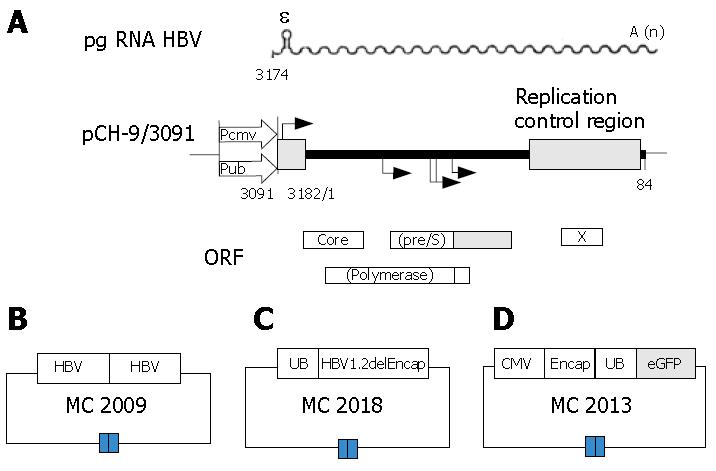Copyright
©2007 Baishideng Publishing Group Co.
World J Gastroenterol. May 7, 2007; 13(17): 2490-2495
Published online May 7, 2007. doi: 10.3748/wjg.v13.i17.2490
Published online May 7, 2007. doi: 10.3748/wjg.v13.i17.2490
Figure 1 Schematic representation of plasmid constructs.
A: Plasmid constructs used for the production of recombinant hepatitis B virus (rHBV)[10], (pgRNA HBV = sinusoidal line; ε = encapsidation signal; A (n) = poly A tail; CMV = cytomegalovirus; UB= ubiquitin); B: The vector MC2009 contains 2 tandem copies of HBV genome; C: The transfer plasmid DNA vector MC2013 obtained by replacing a DNA fragment containing the small envelope gene (HBV position 1446 to 2347) with a PCR fragment encoding a fluorescence-enhanced green fluorescence protein (eGFP), meanwhile, a DNA fragment encompassing the HBV preS2/S promoter was substituted by a PCR fragment encoding UB promoter which could drive transgene expression. A CMV promoter was introduced to drive the expression of the UB.eGFP reporter expression cassette with the HBV encapsidation signal, and premature stop codons were introduced into all remaining HBV open reading frames; D: The helper plasmid MC2018 contains only one copy of the HBV genome with a deletion of the encapsidation signal ε or direct repeats necessary for reverse transcription. The UB promoter was introduced to drive expression of HBV 1.2delEncap.
- Citation: Li SH, Huang WG, Huang B, Chen XG. High expression of hepatitis B virus based vector with reporter gene in hepatitis B virus infection system. World J Gastroenterol 2007; 13(17): 2490-2495
- URL: https://www.wjgnet.com/1007-9327/full/v13/i17/2490.htm
- DOI: https://dx.doi.org/10.3748/wjg.v13.i17.2490









